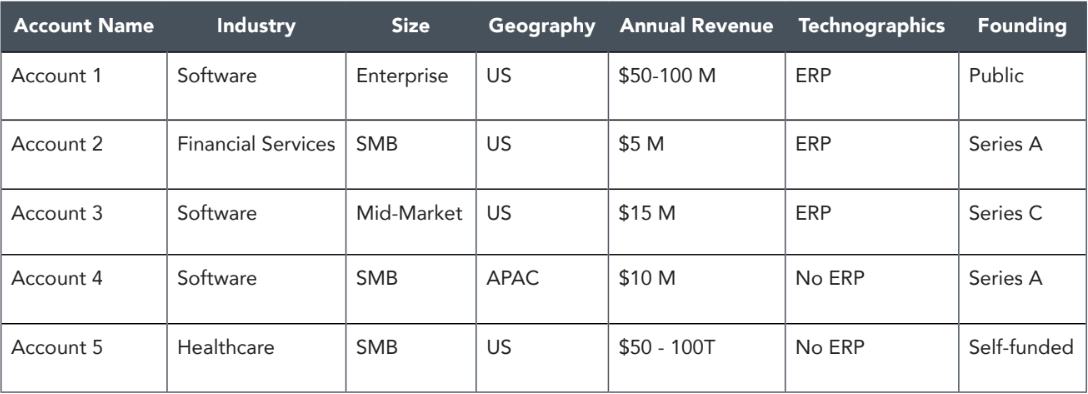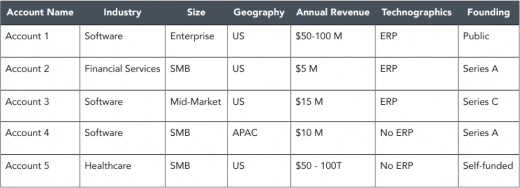Evaluating Your Account-Based Landscape: How to Identify Your Total Addressable Market & Ideal Customer Profile
— June 12, 2019
The Account Intelligence Arms Race
Whether you know it or not, you are in an account intelligence arms race. Tomorrow’s winning B2B companies will be the ones that are able to centralize intelligence from multiple sources at an account level and be able to take action quickly across their sales and marketing channels.
Right now, your competition is finding more advanced ways to collect and synthesize account data, identify key target accounts, and connect with relevance in a timely fashion (creating a blockade for your sales teams).
Success in B2B marketing and sales is now a game of inches, not feet. And it starts with effective, data-driven, and dynamic targeting built on new types of account data that you can take action on immediately –– not tomorrow or next week.
But before you can target and engage your ideal accounts, you’ve got to find out what your account-based landscape looks like (simply put: how many accounts could you be targeting?).
You do this by defining your total addressable market (TAM) and ideal customer profile (ICP). Before we show you how to do this, let’s clearly define what these two terms mean (and explain how they’re different).
What Does Total Addressable Market (TAM) Mean?
Your TAM is made up of all the accounts you could possibly ever sell to. This is the entire revenue potential of your current set of products and services. In a B2B account-based strategy we translate this to the number of companies, or rather, accounts, we could sell to.
What Does Ideal Customer Profile (ICP) Mean?
An ICP is often confused with a buyer persona – but they’re referring to two separate things. Unlike traditional inbound marketing, ABM doesn’t necessarily require in-depth, character-driven personas (think “Megan the Marketer”). Instead, an Ideal Customer Profile is a description of the company that’s the best fit for your product or service (and when you’re talking about the people on the buying committee at that company, it’s a buyer persona).
Example:
Let’s say you’re a legal SaaS company focusing on marketing to large law firms. Your TAM might encompass every law firm that could benefit from the use of your software, however, your ICP will probably look quite different. To put it in perspective, while you might be able to sell your software to solo and small firm attorneys focusing on civil litigation, these firms don’t offer the same revenue opportunity as larger, sometimes enterprise-level firms – and they probably won’t benefit as much from your solution. Your ICP, therefore, might look something like this: “Law firms – in any practice area – with 100 or more associates, multiple locations, and $ 50M+ in annual revenue.”
P.S. To check out an example of a real-life legal SaaS company seeing success with ABM, click here.
Your ICP should focus on relevant characteristics of your target accounts, such as:
- Industry/vertical
- Geography
- Employee headcount — companywide
- Technology they use and within key departments
- Size of their customer base
- Annual revenue
- Level of organizational or technological maturity
- Budget
How Are TAM And ICP Different?
As described above, your TAM is the total number of accounts that could buy your product or service (to refer back to the example, it could be any attorney, anywhere). But, just because a company could buy your product doesn’t mean you should invest valuable time and resources in marketing to them.
Your resources are scarce. Even if you sell a SaaS tool, there is a cost in people and resources for every customer you bring on. Someone has to help manage your customers, create new features to keep them happy, and you need a support staff to manage those people.
So even if your product could potentially serve an infinite number of people, that doesn’t mean you have the resources at your disposal to handle that volume of output.
The point is that you should view your product as a scarce resource, no matter how much availability there actually is.
This is where your ICP comes into play. Whereas a TAM is more of a fuzzy, idealistic number of accounts, ICP is the realistic number of accounts that you should focus on. These are the accounts that are easiest to convert into opportunities, have the shortest sales cycles, and become the happiest customers.
Keep in mind that you probably won’t target every company that fits your ICP at the same time. It would be great if you could, but most companies don’t have the resources to target the entirety of their ICP all at once. And if you define your ICP and find that you do actually have the budget and bandwidth to target the entire list of accounts, you were probably too restrictive in defining it!
Example: How Would Salesforce Define Their TAM And ICP?
If we go all the way back to 1999, Mr. Benioff probably had a very different TAM and ICP than he has today. Back in 1999, Salesforce’s TAM would have been any company that could possibly ever buy a CRM. Their ICP, however, was most likely something such as, “B2B companies in the tech industry, with 100 or more customers, and ten or more salespeople.”
Today, Salesforce’s TAM is estimated at $ 140 billion. They have a large list of products that can serve a much larger number of industries and people, but for the sake of simplicity, let’s just look at the current TAM and ICP of their CRM tool.
Although Salesforce’s TAM has grown tremendously, their CRM TAM is about the same as it was in 1999. While there has, of course, been some growth in the market, the overall number of companies that could ever possibly purchase a CRM has stayed relatively the same. Their ICP, however, has changed dramatically.
Today, their ICP would be something such as, “Companies — B2B and B2C — in the technology, financial services, utility, healthcare, agriculture, education, and manufacturing industries, with fifty or more customers, and five or more salespeople.”
How To Define Your ICP
To define your ICP you need to identify the firmographic, environmental, and behavioral attributes of your best customers. You will do this by building lists of your best customers, filling out their firmographic, environmental, and behavioral attributes, and uncovering patterns and similarities.
For example, if you sell a Saas product to real estate brokerages, your best customers may only be located in hot markets, have 50+ employees, who list a high volume of properties annually. It probably won’t include a broker in a less competitive location who only lists one property a month.
Lists You Will Need:
It’s hard to provide explicit instructions for qualifying your best customers because every organization’s “best customer” is unique. However, our recommendation is to look for customers with the highest feature adoption rates, product usage, or likelihood to renew.
Don’t have this info on hand? No problem – just take a look at all the accounts who have been customers for two or more years.
If you’re a newer company or an established company moving into a new market, you might not have enough customers to form a baseline. In this case, your ICP will be largely based on assumptions and require you to do market research to fill in the criteria.
Example
Inputs
- Active customers
- Accounts that have been customers for over two years
- Customers with a churn score over 7 (on a scale of 1 – 10 with 10 being best)
- Customers with 80% feature adoption
Outputs

Analysis
The majority of accounts on this best customer list are U.S.-based SMB companies that have been venture funded, have ERP, are in the software industry, and have over five million in annual revenue. Companies that fit this profile make up your ICP.
Ideal Customer Profile:
- Geography: US
- Size: SMB
- Funding: Yes
- ERP: Yes
- Annual Revenue: Over five million
How To Identify Companies That Fit Your ICP
Your ICP is a set of characteristics that identify the accounts that will have the most success with your product (and be the most profitable for your company.)
In many cases, those attributes are a mix of:
- Things that can be easily identified prior to beginning your marketing and sales efforts
- Characteristics that you need to discover through research
Start with accounts that you have in your CRM and narrow the list down to those that have the firmographic fit for your ICP.
For the attributes that you don’t have in your CRM, you’ll need to consult outside data sources that can reasonably identify other characteristics that fit your ICP. A good example would be: if your solution is most valuable to companies that are growing their software development efforts, you could find a data source that looks for companies that are actively hiring software engineers.
There’s a three-step process for identifying companies that fit your ICP.
Step 1: Evaluate Your CRM
Questions to Ask:
1. Do you have a complete list of accounts that fit your ICP?
2. Do you have data on the firmographic, environmental, and behavioral attributes of accounts that fit your ICP?
3. Are the accounts and data accurate?
Step 2: Identify Data Gaps
1. Do you need to find more accounts in a given industry or geographic territory?
2. Do you need data on a given account attribute?
Step 3: Enhance Account Data
Once you’ve identified the gaps in your CRM, you can leverage outside data sources to start filling those gaps. Companies such as Datafox, DiscoverOrg, and Datanyze are good places to start.
Next Steps: Tiering Your Account Lists
Once you’ve calculated your Total Addressable Market and defined your Ideal Customer Profile, you might be tempted to start running campaigns to that entire audience. But there’s another step you need to take – you’ve got to figure out which accounts you’d like to pursue right now, and which you’d like to target later on in the month/quarter/year.
By segmenting your account lists based on priority (i.e. how likely they are to engage, how well they fit your ICP, etc.) you can better organize and prioritize your marketing and sales outreach. Then, you can develop a marketing cadence (we recommend quarterly), during which time you’ll pursue a different segment of target accounts. This helps to focus your marketing and sales efforts on a mutually agreed upon account list and also avoids wearing out your entire TAM/ICP (the dreaded ad fatigue is real!).
Business & Finance Articles on Business 2 Community
(37)


